MAXILLOFACIAL TRAUMA: BLUNT-FORCE FRACTURES AND PENETRATING INJURIES
KEY POINTS
- Imaging findings in facial trauma are critical to treatment decisions, including precise surgical planning.
- Imaging can identify findings that are critical to prognosis.
- Imaging may help detect important complications such as infection or retained foreign bodies.
Blunt-force and penetrating trauma may result in both soft tissue and bony injury. This chapter describes common patterns of maxillofacial fractures, excluding the mandible (Chapter 98), except those that are primarily of the orbit and discussed in Chapter 63. It also discusses the effects of penetrating trauma and the evaluation of possibly retained foreign bodies. Vascular malformations due to facial trauma are discussed in Chapter 59.
ANATOMIC AND DEVELOPMENTAL CONSIDERATIONS
Applied Anatomy
The relevant anatomy of the bony orbit, muscle cone, and related neurovascular structures is discussed in detail in Chapter 44. The mandibular anatomy is discussed in Chapter 96 and that of the temporomandibular joint in Chapter 101.
The maxillary bones, shaped as four-sided pyramids, are cornerstones of the facial skeleton as the maxilla bridges the frontoethmoidal complex above and the occlusal plane with the mandible inferiorly. In the transverse plane, the maxilla supports the paired zygomatico-orbital complexes.
Three paired midface vertical buttresses of the midface include the nasomaxillary buttress, the zygomaticomaxillary buttress, and the pterygomaxillary buttress. Functionally, these buttresses support the face against the vertical forces of mastication. A weaker midline buttress, the frontoethmoidal-vomerine, supports the midline.
The horizontal buttresses are relatively frail compared to the three main vertical buttresses. These include superior alveolar ridges, palate, and inferior orbital rims.
IMAGING APPROACH
Techniques and Relevant Aspects
The sinonasal region and face is studied with computed tomography (CT) and magnetic resonance (MR) techniques described in detail in Chapter 78. Specific CT protocols by indications are detailed in Appendix A. Specific MR protocols by indications are outlined in Appendix B. Almost all studies to investigate facial trauma are done without contrast except if an infectious complication or vascular malformation is suspected.
Pros and Cons
CT is done routinely for the evaluation of facial and sinonasal injury and typically is sufficient for all medical decision making. Emergent evaluation with CT is indicated for possible associated tension orbit. Magnetic resonance imaging (MRI) is used occasionally to assess optic nerve compromise (Chapter 54).
Delayed complications such as mucoceles, hematic cysts in old subperiosteal or other hematomas, or encephaloceles may be more definitely diagnosed by MRI.
MR is used adjunctively in highly selected cases of penetrating trauma with possibly retained foreign bodies and in those complicated by infection that might result in intracranial complications.
Plain films may be used to confirm proper gross placement of components of constructs but have essentially little if any definitive primary role if CT is available except for orthopantomography for mandibular injuries.
SPECIFIC DISEASE/CONDITION
Blunt-Force Trauma and Facial Fractures
Etiology
Acute trauma to the face, paranasal sinuses, nasal cavity, and mandible may be blunt force or penetrating from a wide variety of untoward events. Both mechanisms can also occur during surgery, and both may result in the presence of retained foreign bodies. The chronic effects of facial trauma due to those mechanisms are also discussed in the next section.
Clinical Presentation
Fractures may present with only soft tissue trauma or a hematoma. Facial deformity, either visible or palpable, suggests fractures. Each type of facial fracture is generally associated with an expected possible array of signs and symptoms. These are discussed in the following section on patterns of disease. Since the fractures may be complex, such phenomena are possible in more than one specific type of fracture.
Loss of vision caused by fractures described both in this chapter and in Chapter 63 on orbital injury may be due to eye injury, optic nerve/sheath injury, and/or tension orbit.
Associated retained foreign bodies may be suggested by the physical examination or mechanism of injury.
Pathophysiology and Patterns of Disease
The facial skeleton forms a series of struts in the vertical, horizontal, and sagittal planes described in the previous Applied Anatomy section of this chapter.
The buttresses serve as a crumple zone or shock absorber for a vertical force directed from the facial skeleton to the skull base. The nasomaxillary buttress directs force from its canine area to the pyriform rim, more mesial part of the supraorbital rim, and the frontal process of the maxilla. The zygomaticomaxillary buttress directs force from the alveolar crest through the zygoma, the more lateral aspect of the superior orbital rim, and temporal bone. The pterygomaxillary buttress directs force through the palatine bone to the pterygoid plates and basisphenoid.
Weaker horizontal buttresses exist in the form of the superior alveolar ridges, palate, and inferior orbital rims. These are much more frail than the vertical buttresses. This arrangement allows vertical impact to be absorbed better than the shear that occurs with horizontal impact forces.
Fractures interrupt these buttresses/struts, and the repair of facial injury aims at restoring the structural integrity of the struts by creating a framework for optimal restoration of function with a good cosmetic result. Fractures of the face, except for those of the mandible and the zygoma, are not liable to the effects of muscle pulls with regard to the final position of the resulting fragments. For instance, the masseter muscle origin on the zygoma can result in distraction of an unrepaired zygomaticomaxillary fracture. Muscles that attach to the maxillary framework are those of the superficial musculoaponeurotic system, and they mainly insert within the skin so that they do not contribute to the anatomic deformity. Specific functional losses may be anticipated based on the pattern of injury. Besides cosmesis, bony injury patterns will suggest the risk of cerebrospinal fluid (CSF) leakage and malocclusion as potential complications that may require specific attention. Nasomaxillary buttress fractures with medial displacement can narrow the pyriform aperture and cause nasal airway obstruction. The bones of the midface also support, transmit, and protect important structures that may be damaged during injury or surgery. Trauma may injure the infraorbital nerve, distal branches of the internal maxillary artery, and orbital contents.
Facial and orbital fractures in children may be buckled rather than frankly fractured. These may result from relatively minor trauma and tend to have a lesser association with complications than fractures in adults.
Le Fort, nasoethmoidal, and other non–Le Fort fractures are discussed in this chapter. Blowout and orbital zygomatic complex fractures are discussed in Chapter 63.
Le Fort Fractures
Patterns of fracture propagation due to blunt midface trauma were systematically studied by René Le Fort in 1901. Fracture patterns described by Le Fort coincide with fractures that go through the junctions of horizontal and vertical buttresses, at suture lines and areas of thinner bone. However, facial trauma most often produces complex forces with facial fracture patterns not often conforming to “classic” unilateral or bilateral Le Fort patterns. Comminuted, “crush” injuries to the anterior maxillary wall or nasoethmoidal complex fractures are common examples of injuries that do not fit into a classic Le Fort classification. Fracture lines often do not follow Le Fort patterns; thus, mixed, unilateral, or other variants are so common as to be the rule instead of the exception. High-energy events may involve the entire midface, mandible and calvarium and are sometimes referred to as “panfacial.”
Le Fort I
Le Fort I fractures are mainly in the horizontal plane. They result from a downward force typically applied to the lower aspect of the maxillary alveolar rim, resulting in a mobile maxilla by fracturing all four of the vertical buttresses of the midface. The fracture extent is shown in Figure 88.1. It will typically interrupt the pterygoid plates.
Le Fort II
Le Fort II fractures have a pyramidal shape (Figs. 88.1 and 88.2–88.5). They result from a force typically applied to the lower or mid maxilla. The pyramidal shape is related to the manner in which it extends obliquely inferiorly from the nasal bridge to the frontal processes of the maxilla, lacrimal bones, and anterior orbital floor and rim continuing through the anterior wall of the maxillary sinus, fracturing the lateral zygomaticomaxillary buttresses. It then travels posteriorly beneath the zygoma and through the pterygoid plates.
Le Fort III and More Advanced Injuries
Le Fort III fractures are also referred to as complete craniofacial dysjunction or dislocation (Figs. 88.4 and 88.6). They result from a force typically applied to the nasal bridge and transmitted through the upper maxilla. The weak zones that fracture include the nasofrontal and frontomaxillary sutures, nasolacrimal groove and ethmoid bones, the floor of the orbit (typically along the inferior orbital fissure) lateral orbital wall including the frontal zygomatic suture junction and the zygomatic arch. The fracture also extends within the nasal cavity to involve the perpendicular plate of the ethmoid, vomer, and finally the pterygoid plates near the base of the sphenoid bone.
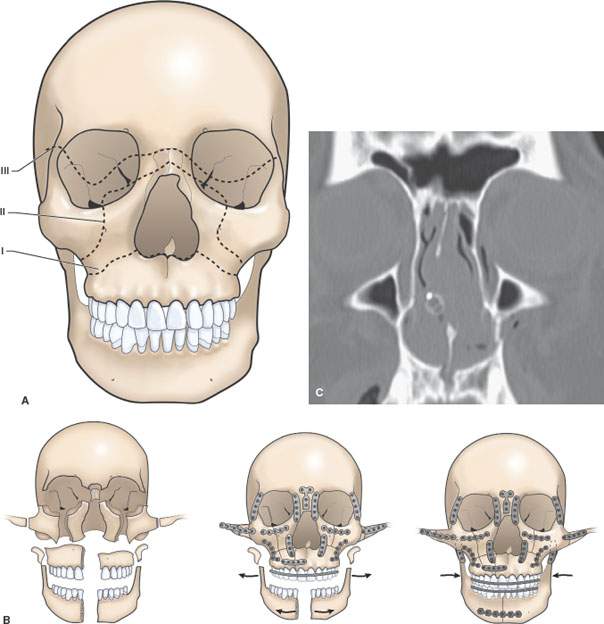
FIGURE 88.1. A: Schematic diagram showing fracture patterns of Le Fort injuries as indicated by I–III. B: Three schematics showing generalized patterns of midface and mandibular injuries. From left to right, the images show methods of open reduction and internal fixation of these fractures. This is largely accomplished with miniplates and miniscrews sometimes augmented by mesh and compression plates. The center image shows stabilization of the midface including the maxilla and palate. The far right diagram shows that once the midface is stabilized, the mandibular fractures can be repaired and then stabilized by intermaxillary fixation. Note also that the mandibular condylar head fracture dislocation would also need to be reduced and repaired. C: Computed tomography study of a patient with multiple facial injuries. The fracture through the maxilla (arrow) appears to be subtle. It was not reported originally. This resulted in malocclusion with an additional procedure being required to restore the patient’s occlusal plane. Clinically, this was considered to be a unilateral Le Fort type I injury.
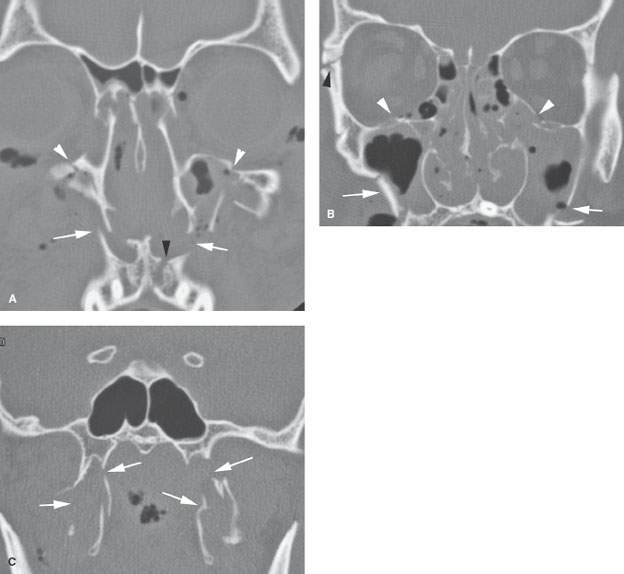
FIGURE 88.2. Computed tomography study of a patient with a Le Fort–type midface fracture. A: Coronal sections show the comminuted fractures extending through the nasomaxillary buttress (arrows). The comminuted fractures of the anterior maxilla canine fossa (arrowheads) show how forces are transmitted from this buttress to the canine area. In this patient, the premaxilla is fractured; this fracture continued into the hard palate posteriorly. B: More posteriorly, fractures involve the zygomaticomaxillary buttress (arrows). These fractures extend through the orbital floor, usually displacing fragments upward and somewhat inward (white arrowheads). This buttress transmits forces laterally toward the orbit, as is manifest by the fracture of the lateral orbital wall (black arrowhead). C: Section through the posterior aspect of pterygomaxillary buttress shows comminuted fractures of pterygoid plates (arrows).
Naso-Orbital-Ethmoidal and More Simple Nasal Fractures
The naso-orbito-ethmoid (NOE) complex is composed of a group of bones that separates the nasal, orbital, and cranial cavities. The nasal, frontal, maxillary, ethmoid, lacrimal, and sphenoid bones all contribute to the NOE complex. Most NOE fractures result from central facial impact forces that exploit the differences between the stronger vertical struts and weaker horizontal struts, particularly when the applied force is directed in a more anterior to posterior orientation. The prominent position of the NOE complex anteriorly in the mid face also makes it susceptible to injury.
These fractures may be simple or severely comminuted. The more simple fractures, if displaced, will typically show the nasal bones and frontal process of the maxilla to be telescoped posteriorly beneath the frontal bone (Figs. 88.7 and 88.8). Comminuted fragments may spread medially into the nasal cavity, superiorly to the anterior cranial fossa, and laterally into the orbit. These patterns explain the association of NOE fractures, when due to high-energy impact, to be associated with CSF leak and brain and globe injuries.
Telescoping of the bones of the NOE complex between the ethmoidal labyrinths will increase the transverse distance between the medial orbital walls (Figs. 88.7 and 88.8). Rupture or avulsion of the medial canthal tendon (MCT) (or its bony insertion) can also result in a greater intercanthal distance, and this feature of NOE fractures must be determined only by the clinical examination. This injury spreads the attachments of the medial canthi, resulting in telecanthus, which is defined as increased distance between the medial canthi. The eyelids insert around the lacrimal fossa through the MCT. The telecanthus results from MCT movement from its usual position while remaining attached to a bone fragment that has become displaced. Telecanthus requires four fracture sites, including the medial orbital wall, the nasomaxillary buttress and inferior orbital rim, the frontal maxillary junction, and the lateral nasal bone. The main goal of surgery is to restore the anatomic position of the MCT and the displaced bony fragment(s) to which it may remain attached; this will prevent significant subsequent lid cosmetic and functional problems.
The status of the resulting central segment of bone left by a NOE fracture is the basis of the classification of fracture patterns for this type of injury. The Manson system classifies these fractures into three main groups: type I, where the fractured bony segment is large and the MCT insertion around the lacrimal fossa is intact; type II, where the buttress is comminuted and the MCT attached to a small bone fragment; and type III, where the pattern cannot be diagnosed with imaging requiring exploration to determine if the canthus is avulsed from the bone (Figs. 88.7 and 88.8).
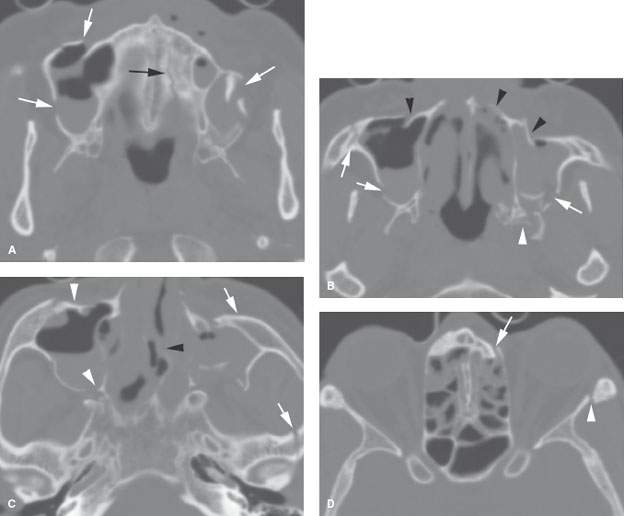
FIGURE 88.3. Axial sections of a Le Fort–type injury showing the effects on the buttress system of the face. A: There is a fracture of the hard palate (black arrow); this is extremely important to recognize considering the internal fixation process. Otherwise, there are comminuted fractures through both the nasomaxillary and zygomaticomaxillary buttresses. B: A more cephalad section than in (A) shows comminuted fractures of the nasomaxillary buttress (black arrowheads) and of the zygomaticomaxillary (white arrows) and pterygomaxillary buttresses (white arrowhead). As is often the case, the fractures are more severe on one side than the other. C: Fractures on the right are through the nasomaxillary and pterygomaxillary buttresses (white arrowheads). On the left, both are also interrupted and there is a fracture through the root of the zygoma (white arrows) resulting in posterior displacement of the zygomatic complex. There is also a nasal septal fracture (black arrowhead) that could be associated with a septal hematoma. D: The forces of the fracture on the left side were transmitted through the buttresses to involve the frontoethmoidal junction on the right and the high lateral orbital wall on the left. Overall, this injury was consistent with a Le Fort type II on the right and type III on the left.
Other potential complications of NOE fractures are also predictable based on related anatomic relationships. Anterior skull base dural injury may result in CSF leak (Figs. 88.7 and 88.8). The anterior and posterior ethmoid foramina lie at the junction of the superior aspect of the frontal and ethmoid bones within the frontal ethmoid suture. Shearing of the traversing arteries may cause an orbital hematoma or impressive epistaxis. The optic canal is typically not directly involved by bony injury, but edema within the optic canal or free bone fragments may disrupt optic nerve perfusion.
Other Non–Le Fort Midface Fracture
Limited, blunt trauma due to a force sometimes delivered by a weapon may result in small, isolated fracture fragments or localized crush injuries. These tend to occur along the alveolar ridge, anterior of the maxillary sinus and nasomaxillary junction, since structures project forward. Also, submental forces directed superiorly may produce vertically oriented fractures through various horizontal bony struts such as the alveolar ridge, infraorbital rim, and zygomatic arches.
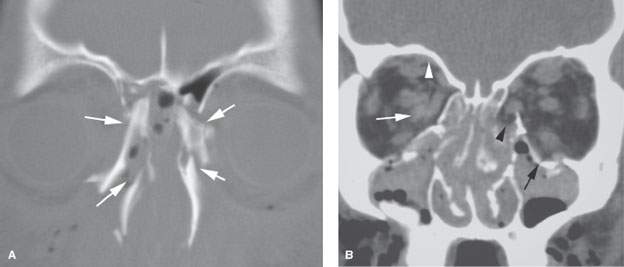
FIGURE 88.4. Midface fractures of the Le Fort type can result in substantial injuries to the nasoethmoidal complex. A: A severely comminuted fracture of the nasoethmoidal complex that presents a substantial challenge to the repair of the intercanthal region. B: Soft tissue computed tomography viewed more posteriorly shows that such injury is often associated with intraorbital complications. On the patient’s right, there is a subperiosteal hematoma along the orbital roof (white arrowhead) and intraconal bleeding (white arrow). On the left, the medial orbital wall fracture may be trapping the medial rectus muscle (black arrowhead). There is a substantial downwardly displaced orbital floor injury (black arrow) that might lead to complications of orbital floor blowout injury.
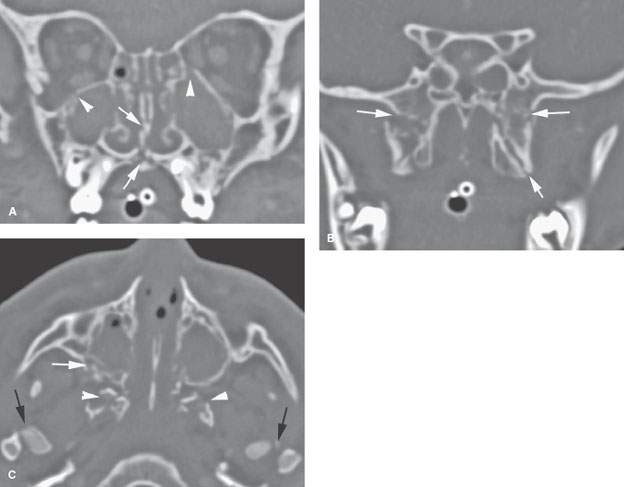
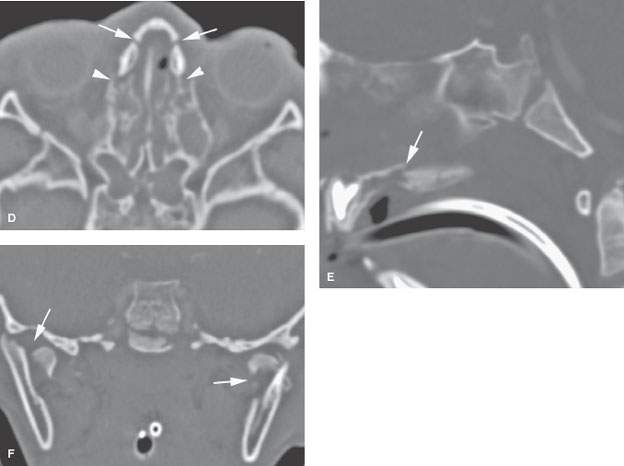
FIGURE 88.5. Facial injuries in the younger pediatric age group will sometimes show atypical patterns or more buckled type of patterns. This toddler suffered a severe midface injury in an auto accident. A: The basic pattern is that of a Le Fort injury. The orbital floors are displaced upward, especially on the right (white arrowheads). There is substantial injury to the nasal septum and hard palate (arrows). B: Posterior fractures through the pterygomaxillary buttresses show comminuted fractures fairly typical of Le Fort–type injury (arrows). C: On this image, the nasomaxillary and zygomatic maxillary buttresses are relatively intact compared to the pterygomaxillary buttresses. A posterior zygomaticomaxillary buttress injury is present (white arrow) at the junction with the pterygomaxillary buttress, which is severely comminuted (arrowheads) especially on the right side. In this patient, there are also bilateral fracture dislocations of the condylar heads of the mandible (black arrows). D: The energy transmitted superiorly involving the nasal bones (arrows) and ethmoid and lacrimal bones (arrowheads) is in a distribution most consistent with a Le Fort II type of pattern. E: Sagittal reformations show the significantly hard-placed palate injury (arrow). F: Coronal reformation confirms the fracture dislocations of the mandibular condylar heads (arrows).
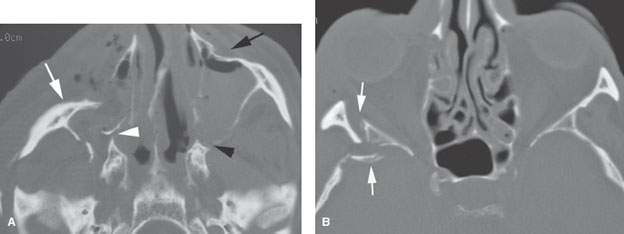
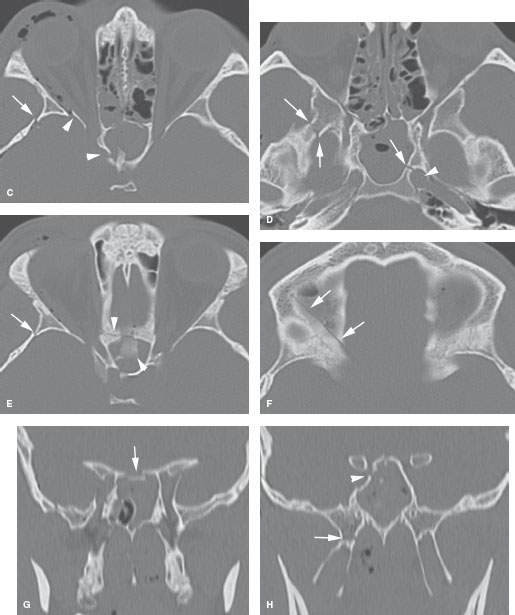
FIGURE 88.6. Two patients showing how the more advanced Le Fort–type midface injuries may also involve what has been referred to as the sphenomaxillary buttress. Such fractures are generally associated with risk of intracranial and orbital complications. A, B: Patient 1. In (A), on the left side, there is injury to a nasomaxillary (black arrow) and pterygomaxillary buttresses (black arrowhead). On the right side, the midface is shattered with severely displaced injury of all three buttresses (white arrow and arrowhead). In (B), the fracture energy continues posteriorly and superiorly to shatter the greater wing of the sphenoid (arrows). C–H: Patient 2. In (C), such energy often continues superiorly to involve the pterional region of the greater wing of the sphenoid and lateral orbital wall (arrow), resulting in disruption of bone in the orbital apex and extending into the central skull base (arrowheads)—injuries that pose risk to the optic canal. In (D), the energy directed more inferiorly in these fractures often extends into the base of the sphenoid and body of the sphenoid bone (arrows) and may cross the carotid canal (arrowhead), raising the risk of carotid injury. In (E), the laterally directed forces interrupting the anterior and lateral portions of the central skull base (arrow) often extend across the midline in the central skull base (arrowheads), raising the risk of cerebrospinal fluid leakage. In (F), as these injuries continue into the orbital roof (arrows), they are frequently associated with subperiosteal hematoma within the orbit and possibly subfrontal and subtemporal intracranial subdural and epidural hematomas. In (G), the coronal view shows the displaced fragment of the planum sphenoidale (arrow) with a relatively minor amount of disruption of the pterygoid plates. In (H), disruption in the optic canal region suggests the possibility of optic nerve compromise. Fracture through the pterygoid plate is consistent with injury in a Le Fort–type pattern.
Stay updated, free articles. Join our Telegram channel

Full access? Get Clinical Tree








